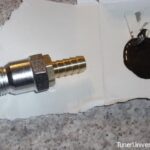The dreaded “100% full DPF see dealer” warning light can induce panic in any diesel truck owner. This warning, often accompanied by the P0428 diagnostic trouble code (DTC), indicates a potential issue with the diesel particulate filter (DPF) system, specifically pointing towards a catalyst system efficiency below threshold (Bank 1). While a trip to the dealership might seem inevitable, a DIY approach can sometimes save the day, and a significant amount of money. This article details a personal experience resolving the P0428 code without expensive parts replacements.
Decoding the P0428 Code and Initial Troubleshooting
The P0428 code specifically suggests a problem with the catalytic converter’s efficiency. In diesel engines, this often relates to the DPF, responsible for trapping soot particles from exhaust gases. My initial attempt to address the issue involved using AlfaOBD software to force a DPF regeneration. However, this process was consistently interrupted after about five minutes due to a “cat temp circuit high” error. The diagnostic graph displayed a sudden spike in catalyst temperature from a stable 630°C to 999.9°C, causing the system to abort the regeneration. Replacing the temperature sensor, estimated at $200 CAD, seemed like the next logical step.
A Simple Solution: Cleaning the EGT Sensor
Before resorting to replacing the sensor, a friend suggested cleaning the exhaust gas temperature (EGT) sensor located in the exhaust manifold. Soot buildup on this sensor can disrupt its readings, potentially triggering the P0428 code and causing regeneration failures. Accessing the sensor was surprisingly straightforward. After removing the passenger-side wheel well liner, the sensor was easily visible above the DPF, connected to the exhaust manifold.
The Cleaning Process and a Cooling Strategy
The EGT sensor was carefully removed after applying WD-40. It was then soaked in a container of diesel fuel for 30 minutes to dissolve any accumulated soot. After cleaning and drying the sensor with compressed air, it was reinstalled.
As an extra precaution, a high-speed fan was placed under the truck to help cool the DPF. The goal was to maintain the DPF temperature below the critical threshold that triggered the previous sensor errors. Surprisingly, this simple cooling method proved effective, lowering the DPF temperature by approximately 20°C and significantly slowing the temperature rise during regeneration.
Successful Regeneration and Cost Savings
With the cleaned EGT sensor and the cooling fan in place, another forced regeneration was initiated. This time, the process completed successfully within 20 minutes, reducing the DPF soot load to 10% and clearing all error codes. The entire fix, remarkably, cost nothing.
Conclusion: P0428 Troubleshooting Can Be Simple
While the P0428 code can be intimidating, this experience demonstrates that a simple solution might be all that’s needed. Cleaning the EGT sensor can be a cost-effective first step in resolving this issue. While continuous monitoring is recommended, this DIY fix proved successful in this instance. Always prioritize safety and consult reputable sources before undertaking any vehicle repairs. Remember, a basic understanding of the P0428 code and potential solutions can empower you to troubleshoot effectively and potentially avoid unnecessary expenses.

